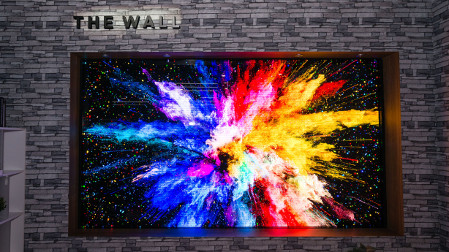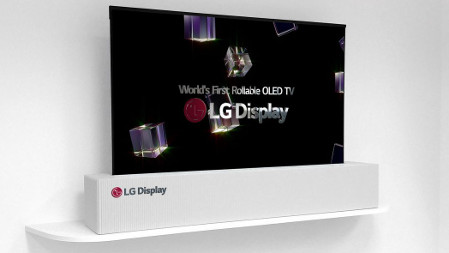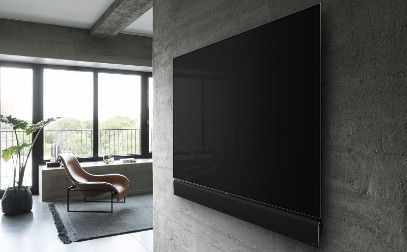CES Marks ATSC 3.0’s Prelude

(L to R): CES President Gary Shapiro, NAB President Gordon Smith and ATSC President Mark Richer raise a glass to the launch of ATSC 3.0 at the 2018 International CES.
LAS VEGAS—Behind the CES glitz of bigger and brighter video displays, voice-activated media controls and high-speed wireless delivery, Next Generation TV was taking shape. In hotel suites and private demo rooms, Sinclair-backed ONE Media (“Open Network Enabled”) said its pilot ATSC 3.0 transmission will begin by late March in a market where its Spectrum Consortium collaborators operate. Separately, the Pearl TV group confirmed that Sony Electronics will develop an on-screen interactive navigation tool for its ATSC 3.0 “Model market project,” which will debut in Phoenix later this year.
EARLY ATSC 3.0 TOOLS
On the ATSC 3.0 front, Airwavz.TV, a Long Island company making ATSC 3.0 “optimization tools,” privately showed its RedZone Receiver (RZR), an $895 dongle that allows broadcasters to check the signal transmission from their NextGen TV transmitters to “ensure it meets coverage and capacity.” Co-Founder and CTO John B. Casey told TV Technology that RZR will be available by early February through its website (www.Airwavz.tv). He described RZR as “specifically tooled” for ATSC 3.0 commercialization for use by field engineers and executives.
The three-inch-long device connects to a computer via USB and an antenna, enabling testing of signal strength and quality from around the proposed viewing area. The initial kit includes a Linux-based software development kit, tabletop antenna, extension cable and one year of technical support.
Casey, who was previously a technical executive at Happaugue Inc., which makes PC-based TV tuners and data broadcast receivers, also said that the Airwavz.TV “Quarterback” protective smartphone case with embedded ATSC 3.0 antenna is on track for delivery later this year. The protective cover has a built-in DVR, on/off button for ATSC TV access and an auxiliary battery—all features that Casey believes will help attract users to broadcasters’ Next Gen TV content rather than other mobile video services. Price and distribution plans for Quarterback will be revealed later this year.
Meanwhile on public display, Hisense, a large Chinese TV maker, showed an ersatz “ATSC 3.0” exhibit (albeit the Ultra High Definition prototype synthesized a transmission from a non-standard device within the booth.) And dozens of people involved in the ATSC 3.0 standard partook in a champagne toast to completion of the standard.
The professional video industry's #1 source for news, trends and product and tech information. Sign up below.
CELEBRATING THE COMPLETION
At a brief gala ceremony in the Convention Center’s Grand Lobby during the show’s opening hours, the Advanced Television Systems Committee celebrated the approval of the remaining standards for the ATSC 3.0 suite of next-generation TV standards.
Marking the milestone, ATSC President Mark Richer was joined onstage by Consumer Technology Association President/CEO Gary Shapiro and National Association of Broadcasters President/CEO Gordon Smith.
[ATSC 3.0 Rollout Can Begin Next Month]
Richer explained that 20 individual standards of ATSC 3.0 “will give broadcasters the ability to utilize new transmission methods and finally bring together innovations in both over-the-air and broadband services.”
Smith promised, “Broadcasters stand ready to take full advantage of the capabilities of the new voluntary standard” and predicted that “ATSC 3.0 gives local stations the ability to merge resources and information like never before.”
Shapiro said that CTA's research anticipates that future growth of digital displays “will be driven in part by this exciting new technology and the amazing features it brings.”
A mile away from the main convention floor, ONE Media and the Pearl TV Group showcased their ATSC 3.0 visions to broadcasters, technology providers, programmers and advertisers. Conveniently located in suites down the hall from each other on an upper floor of the Wynn Hotel, both companies explained their plans.
Mark Aitken, vice president of advanced technology for Sinclair Broadcast Group and a founder of ONE Media, told TV Technology that the big push at CES was a prelude to even more significant ONE Media activities at the NAB Show in April.
“When we get to NAB, we want people to understand that we want to be a collaborative industry... with an end-to-end solution that is monetized by use for big data,” he said. “We’re signing up more customers for development kit tools,” including content producers and interactive sports companies.
As for the “us-versus-them” relationship with the Pearl TV group, Aitken insisted that, “Vectorally we’re all running in the same direction, but at different speeds.” He pointed to the dashboard that ONE Media is building uses programmatic standards approved by the Interactive Advertising Bureau, a trade group initially created for the online advertising industry.
For its part, Pearl TV focused on its own approach to targeted advertising, plus the new Sony navigation system.
NAVIGATING CHANNELS AND SEEING THE BEST SCREENS
In addition to the Pearl TV/Sony deal for ATSC 3.0 navigation, concepts and products for new multiplatform channel control popped up around the show floor. For example, Universal Electronics, Inc. demonstrated QuickSet Cloud, its latest approach for multisite remote control access using Web technologies for TV control and other smart home functions including set-top boxes, televisions, game consoles, smartphones and tablets.
UEI also unveiled a voice remote control for DISH Network Corp. and an advanced voice remote for TiVo. The latter will let TiVo customers conduct universal searches across live TV, on-demand and popular streaming services like Netflix, Amazon, and Hulu.
Meanwhile, the sprawling Central Hall of the Las Vegas Convention Center remained the battleground for big-name, big screen TV showdowns.

Samsung's "The Wall"
Samsung unveiled its prototype of “The Wall” 146-inch TV monitor which uses Micro Light Emitting Diode technology with back-lit local dimming zones to improve black levels. Joe Stinziano, executive vice president for Samsung Electronics America, called MLED “one of the most important and unprecedented TV technologies to debut in more than a decade,” singling out its improvements compared to Organic LED (favored by arch-rival LG).
“This is the TV without the tradeoffs experienced in other technologies, like OLED,” Stinziano said. “It uses non-organic materials and does not require color filters to produce perfect blacks and accurate color.” He emphasized that MLED’s modular structure means that it can be set up in “any size you want, any configuration you can think of.”
Samsung also unveiled a TV monitor that upscales content—including broadcast programs to 8K resolution, using Ailand processing power. Samsung Senior Vice President Dave Das said that as screen sizes increase, “Resolution becomes more important.”
In addition to its Wall TV modular display, Samsung focused in making all its new TV sets intelligent, mainly by bundling its proprietary artificial intelligence Bixby software into the set, featuring voice recognition and tied to other smart home applications, such as light controls and door locks. Samsung’s set includes an intelligent TV program guide.
At the LG booth, both its 65-inch “roll-up” flexible screen (think window-shade or yoga pad) and its 88-inch 8K (7680x4320 pixels) OLED screen were centerpieces, but those just skimmed the surface.

LG flexible screen
LG Electronics said that all of its 4K UHD TT sets being sold in South Korea incorporate ATSC 3.0 tuning circuitry (just in time for Olympics coverage) and that it will support broadcast trials and early-deployment tests of ATSC 3.0 in the U.S. this year. LG TV sets use the company's proprietary AI software plus access via Amazon Alexa. LG also put its emphasis on its own AI technology, called ThinQ, which it incorporated into TV sets and other devices and appliances. LG’s TV line-up includes OLED and LCD sets, with enhanced HDR and 120fps functionality, Dolby Atmos immersive audio, an Alpha 9 intelligent processor and full-array local dimming (FALD) backlighting. All of LG’s LG OLED and its new “Super UHD” AI sets will include 4K Cinema HDR, which supports all major HDR formats, including Technicolor’s Advanced HDR and DolbyVision, Hybrid Log Gamma (HLG), and HDR10.
LG also unveiled the ProBeam compact UHD laser projector that can cast an image up to 150-inches and can handle HDR content. The projector uses LG’s webOS smart TV operating system, giving it access to online streaming apps.
Sony introduced two new series of 4K HDR sets in the LED and OLED lines using the company’s picture-processor and panel-control technologies. Sony also said its A8F technology shifts the audio output from the sides or bottom of the screen in a fusion of sound and image making it appear that voices come from performers’ mouths and sound effects emanate from the action spot on the screen.

Sony 4K HDR set
Like other set-makers, Sony said it has a solution for the blur that often accompanies fast-moving action such as sports on large screens. Its X-Motion Clarity, available on some new displays, uses Sony’s proprietary direct LED-panel local-dimming algorithm to control luminance and optimize.
Sony President/CEO Kaz Hirai also used his presentation to insist that the new products are part of the “rebound of Sony’s consumer electronics business,” which had flagged in recent years, but perked up in 2017.
Panasonic, which has restructured itself in recent years, emphasized its enterprise and smart cities capabilities, but also took an unusual return to the consumer TV category. It unveiled its first OLED sets that support HDR 10+, the open, royalty-free, dynamic-metadata platform for HDR created by 20th Century Fox, Panasonic, and Samsung. New Panasonic TV sets using the technology will be able to stream hundreds of hours of Amazon Prime Video. They will include Dynamic Scene Optimizer function, which uses picture analysis to mimic dynamic metadata when playing an HDR10 source on its new 4K TVs.

Panasonic OLED UHD display
Panasonic's OLED UHD displays so far are aimed only at the European and professional markets—not at the U.S. consumer TV audience. A Panasonic executive told TV Technology that decisions would be made eventually on whether to bring the sets to the U.S., although he offered no timetable.
Hisense also showed its line of UHD TV sets, including a 110-inch 4K UHD “Smart Laser TV.” The company also has added Android TV to its Smart TV operating systems, connecting TVs to virtual digital assistants. The Android TV OS is in three Hisense models that also have 4K Roku TV capability.
COMCAST PUSHING XFINITY INTELLIGENCE
An unusual presence in the Smart Home area of CES’s Tech West exhibits at the Sands Expo Center was the “virtual house” that Comcast built. While operators usually aren’t exhibitors at such shows, Comcast pushed its ability to integrate video as well as other tools in the “Intelligent Digital Home.” The centerpiece was the xFi advanced gateway, that supports DOCSIS 3.1, WiFi and future Internet of Things services.
AN UNENDING CORNUCOPIA AND CONUNDRUM
Beyond the traditional TV set manufacturers’ exhibits, the future of visual communications—especially the role of streamed media—popped up constantly. Even Intel’s sprawling booth devoted extensive space to the company’s video technology which is being used to produce the 2018 PyeongChang Winter Olympics this month. The centerpiece was Intel’s TrueView immersive 3D technology, which also includes Virtual Reality, drones and 5G (Fifth Generation) wireless delivery. Elsewhere in its booth, Intel demonstrated its approach to Augmented Reality (especially potential enhancements for video programming) and new applications for its artificial intelligence systems.
[CES 2018: FCC Members Restate Net Neutrality Stances]
Virtual Reality and Augment Reality were omnipresent throughout CES, with frequent contradictory remarks about the imminence of either process. Aaron Luber, head of AR/VR partnerships at Google, told a Digital Hollywood audience that his company is now undertaking “a big second phase” of VR, saying that 2018 will be “an important year, based on how industry works.” He cited the “great barrier to entry with VR [due to] headsets.”
Elsewhere, advocates contended that Augmented Reality has already crossed the threshold toward mass usage, at least in some demographic categories.
At the panoply of content- and media-centric conferences dotting the CES landscape, producers and distributors speculated about, touted and rebuffed concepts about the relative positions of traditional linear broadcasting and on-demand video distribution via any platform.
Ben Sherwood, president of Disney-ABC Television Group, deftly straddled the line as he described his division’s role in the forthcoming Disney Internet-video subscription service at the Variety Entertainment Summit. He carefully pointed out that, “Every decade, the obituaries are written about television.”
“People sometimes mistake watching the television on the wall for television as distribution,” he explained, easing into a description of “lots of different ways to distribute the best content.” Sherwood then confirmed that his group will supply up to 8,000 episodes from its library of TV productions, plus about four original movies and four original series to the streaming venture, including a new movie based on Disney’s “High School Musical.”
At another conference, Joel Stillerman, chief content officer at Hulu, said that the streaming service will seek to replicate its recent “The Handmaid’s Tale” by creating and acquiring short-form series from “emerging talent” as well as long-form original content. He cited “Castle Rock,” a J.J. Abrams-produced series based on Stephen King characters and “The Looming Tower,” a political story which examines the FBI vs. CIA rivalry as both agencies watched the rise of Osama bin Laden.
For a comprehensive list of TV Technology’s ATSC 3.0 coverage, see our ATSC3 silo.
Gary Arlen, a contributor to Broadcasting & Cable, NextTV and TV Tech, is known for his visionary insights into the convergence of media + telecom + content + technology. His perspectives on public/tech policy, marketing and audience measurement have added to the value of his research and analyses of emerging interactive and broadband services. Gary was founder/editor/publisher of Interactivity Report, TeleServices Report and other influential newsletters; he was the long-time “curmudgeon” columnist for Multichannel News as well as a regular contributor to AdMap, Washington Technology and Telecommunications Reports; Gary writes regularly about trends and media/marketing for the Consumer Technology Association's i3 magazine plus several blogs.

